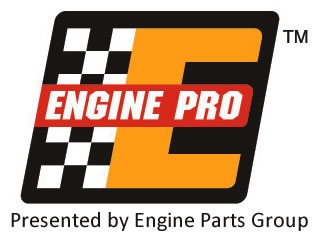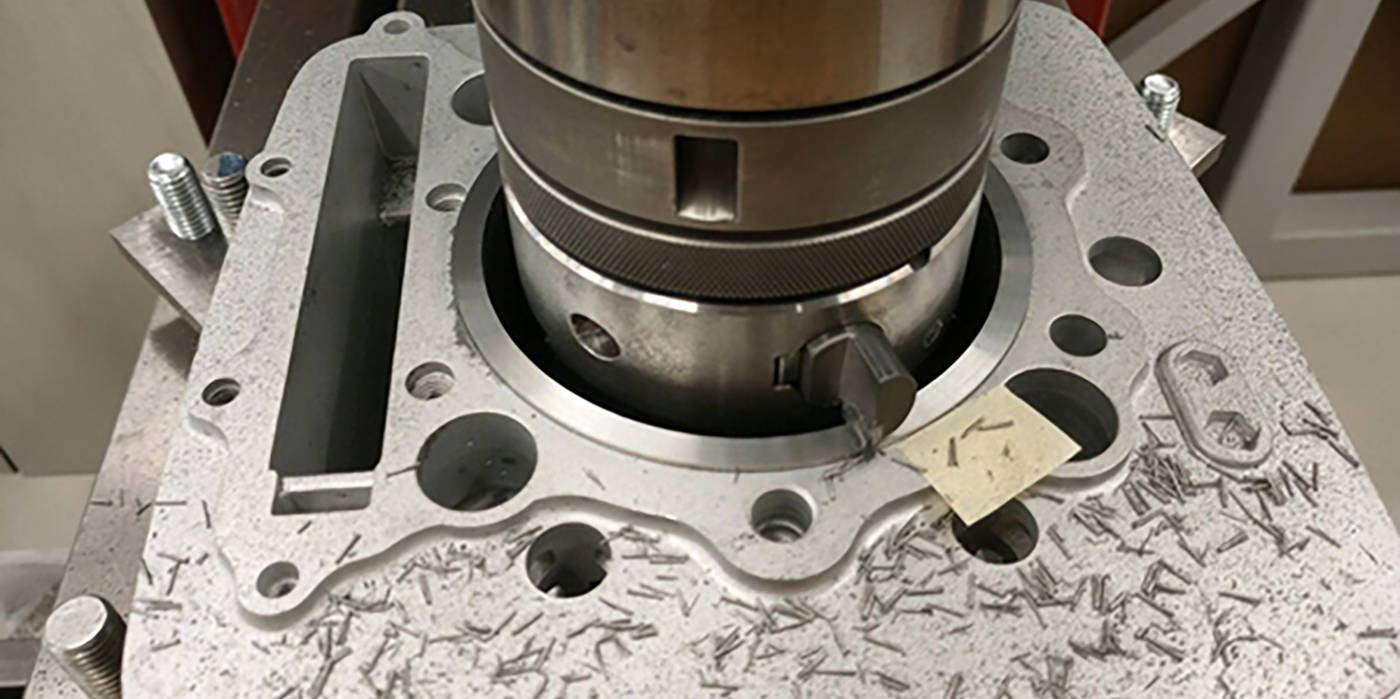Remove The Web
We have noticed through the years that many previously bored blocks come into our shop that have not had the web at the bottom of the cylinders relieved even with the bottom of the cylinders. Depending upon the bore’s oversize, this can be a potential problem point for a quality build. When the web hangs below the bore two problems may occur.
First, the web will bear against the hone head and push it to the side, leaving a bend or small hook in the bottom of the bore, away from the web, and a low spot at the TOP of where the stone stops at the bottom on the web side.
The second problem is that this will usually chip the bottom of the stones. The chipped stones results in this cylinder and the later honed cylinders having a smaller bore/hone size at the bottom of the cylinder. We check every block before honing to catch this potential problem area. We have found that the easiest way to remove the web is to use an extended/long die grinder with two or three 3″ cut-off wheels mounted on an arbor to grind the web away. How to see down in the bore easier? The same place that you bought the cheap extended die grinder also gives you a free small LED flashlight with your purchase, so just tape it to the lower end of the die grinder and you have a very cheap, effective, and well lit web removing tool.
Timm Jurincie
Auburn Auto Machine
Auburn, WA
How To Prevent Re-Ringing
No, I’m not talking about re-ringing a V8. Like most EB readers, I’ve worked around cars and loud noises most of my life. I never gave a second thought to the high-pitched whine of an air ratchet wrench, the sound of a milling machine, or a dragster burnout.
Like many readers, and 40 million Americans, I have Tinnitus or ringing in my ears. Noise-induced hearing loss is one of the most common occupational illnesses.
It is often overlooked because it develops over a long period of time and there are usually no painful effects. Most of us guys are too proud (or dumb) to wear hearing protection, but it’s not too late to start as continued loud noise will make your hearing loss worse.
And young builders should get in the habit of wearing ear protection now. Be sure to enforce a company policy that requires employees to wear hearing protection. If you are not convinced, read OSHA directive CPL 02-02-035. Hearing protection in a machine shop environment is required by law.
Steve Rich
Sterling Bearing Inc.
Kansas City, MO
Hydraulic Roller Valve Lifter Priming Notice
(From G.M. tech bulletin)
Notice: Ensure each valve lifter is filled with clean engine oil and the valve lifter does not tip over (plunger down) before the installation of the valve lifters.
The loss of oil in the valve lifter lower pressure chamber or the dry stroking/cycling of the valve lifter plunger will allow air to travel into the high pressure chamber of the valve lifter. Air in the high-pressure chamber of the valve lifter may not be purged causing extensive engine component damage.
Chris Straub
Straub Technologies
Piney Flats, TN
Inexpensive And Effective Rod Heater
This cheap rod heater is one I’ve used for over 30 years. I’ve bought and sold a few traditional rod heaters, but I like this better. It can be used anywhere in the shop. Replacement bottles are available from the hardware store, camp supply or large discounter.
Randy Torvinen
Torvinen’s Machine
Menahga, MN
Bearing Crush And Vertical Clearance
One of the most important factors in engine bearing design is a proper fit between the bearing and housing. Except for thrust washers, nearly all bearings are an interference fit.
This means the bearing is slightly larger than the hole it fits into. In bushings, we refer to this as “Press Fit.” In half shell bearings it’s called “Crush.” The bearing ends extend slightly beyond the split line of the housing.
The bearings are compressed or crushed down into the housing as the bolts are tightened. This creates a radial contact pressure that holds the bearings tight. Bushings are held by a similar radial pressure as a result of being “pressed” into their housing.
We said crush produces a radial contact pressure between the bearing and housing which holds the bearing in place. This radial contact pressure pushes out against the housing and actually causes the housing to become slightly larger. We call this growth “housing bore displacement.” When the housing displaces there is a corresponding increase in clearance. Typically, connecting rod bore displacement due to crush is about .0005”; main and cam bearing bore displacements are about .0003”.
To determine a bearing’s vertical clearance, (clearance along rod or block centerline) start with housing diameter and subtract bearing centerline wall thicknesses (remember there are two shells) then subtract shaft diameter. What is left is “theoretical vertical clearance.”
If the rod bearing clearance range shown in the catalog is .0007/.0033”, it is .0005” more than the theoretical value calculated. The values shown in the catalog represent the actual assembled vertical clearance range which will occur when the parts are installed.
The locating lug on a half shell bearing registers with a mating slot in the housing to locate the bearing shell. The lug is not intended to prevent bearing rotation.
Crush holds the bearings in place and prevents spinning, just as press fit holds bushings in place which have no locating lugs. Lugs can be positioned differently on upper and lower halves or varied in width to prevent misassembly. A number of late-model engines have even eliminated the location lug completely.
Regardless of lug or no lug, proper positioning of a crankshaft bearing is essential to ensure oil hole alignment with the housing and to prevent interference between the edge of the bearing and the crankshaft fillet radius.
Engine Pro Technical Committee with thanks to Mahle Aftermarket Inc.














